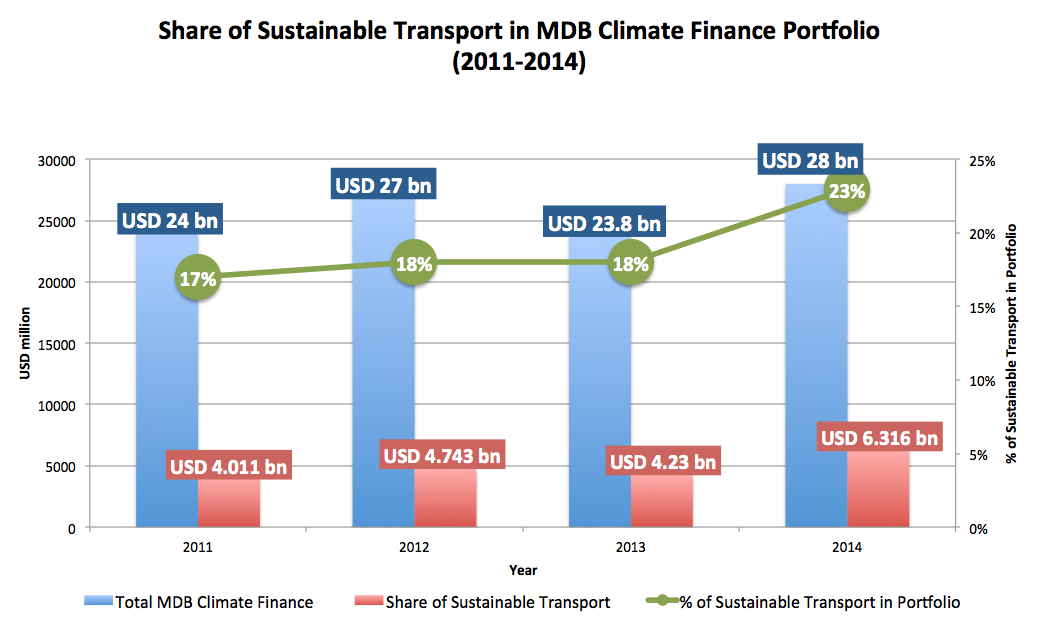Multilateral Development Banks provided $6.3 billion to climate finance for sustainable transport in 2014, accounting for 23% of total portfolio
The recently released 2014 Joint report on Multilateral Development Banks’ Climate Finance indicates that multilateral development banks (MDBs), including the Asian Development Bank (ADB), the European Bank for Reconstruction and Development (EBRD), the European Investment Bank (EIB), the Inter-American Development Bank (IDB) and the World Bank Group (WBG), have provided USD 28.3 billion to climate finance in 2014, of which sustainable transport accounted for 23% (USD 6.3 billion*) of the total portfolio.
Given the pivotal role of public finance agencies in scaling up climate finance, MDBs play a major role to play in mainstreaming climate change and in providing finance in an effective, catalytic manner. Transparent and credible information on finance flows are essential to demonstrate the effectiveness of delivering impacts on the ground. The report covers financing for climate change mitigation and adaptation projects and activities in developing and emerging economies committed by the MDBs in 2014. Out of the total climate finance of USD 28.3 billion, 82% (USD 23 billion) was dedicated to mitigation and 18% (USD 5 billion) was provided for adaptation. 91% of the portfolio came from the MDBs’ own resources, while the remaining 9% came from external resources such as bilateral or multilateral donors, the Global Environment Facility (GEF), and the Climate Investment Funds (CIF).
The 2014 report, along with the previous reports from 2011, 2012, and 2013, shows that the share of sustainable transport in the MDBs’ climate finance portfolio has increaesd from 17% in 2011 (USD 4 bn) to 23% in 2014 (USD 6.3 bn), as shown in the graph below:

Source: MDB Joing Report on Climate Finance (2011, 2012, 2013, 2014)
* Amount of climate finance for Sustainable Transport used in graph is only provided under the MDBs’ mitigation finance portfolio. Specific amount for financing transport activities under the adaptation portolio is not provided in the reports.
The SLoCaT Partnership has been collecting data on transport-focused projects from seven of the main climate finance instruments (CFIs), including the Clean Development Mechanism (CDM), The Clean Technology Fund (CTF), the Global Environment Facility (GEF), TheInternational Climate Initiative (IKI), The Joint Crediting Mechanism (JCM), the Nationally Appropriate Mitigation Actions (NAMA), and the Nordic Development Fund (NDF). The analysis shows that the relatively limited number of transport projects of these climate finance instruments fall far short of investments needed to meet transport-related climate change targets and achieve transport targets under the proposed Sustainable Development Goals (SDGs). It is noted that with over USD 6 billion of financing from the MDBs to the transport sector, this source of climate finance is much larger than the traditional climate finance sources provided by the instruments mentioned above.
Climate finance for the transport sector has been reported under the mitigation activities with the following typology:
Vehicle energy efficiency fleet retrofit
- Existing vehicles, rail or boat fleet retrofit or replacement (including the use of lower- carbon fuels, electric or hydrogen technologies, etc.)
Urban transport modal change
- Urban mass transit
- Non-motorized transport (bicycles and pedestrian mobility)
Urban development
- Integration of transport and urban development planning (dense development, multiple land-use, walking communities, transit connectivity, etc.), leading to a reduction in the use of passenger cars
- Transport demand management measures to reduce GHG emissions (e.g., speed limits, high-occupancy vehicle lanes, congestion charging/road pricing, parking management, restriction or auctioning of license plates, car-free city areas, low-emission zones)
Inter-urban transport and freight transport
- Improvement of general transport logistics to increase energy efficiency of infrastructure and transport, e.g. reduction of empty running
- Railway transport ensuring a modal shift of freight and/or passenger transport from road to rail (improvement of existing lines or construction of new lines)
- Waterways transport ensuring a modal shift of freight and/or passenger transport from road to waterways (improvement of existing infrastructure or construction of new infrastructure)
The full reports for 2011, 2012, 2013 and 2014 are available for download.
* Amount of climate finance for Sustainable Transport used in graph is only provided under the MDBs’ mitigation finance portfolio. Specific amount for financing transport activities under the adaptation portolio is not provided in the reports.